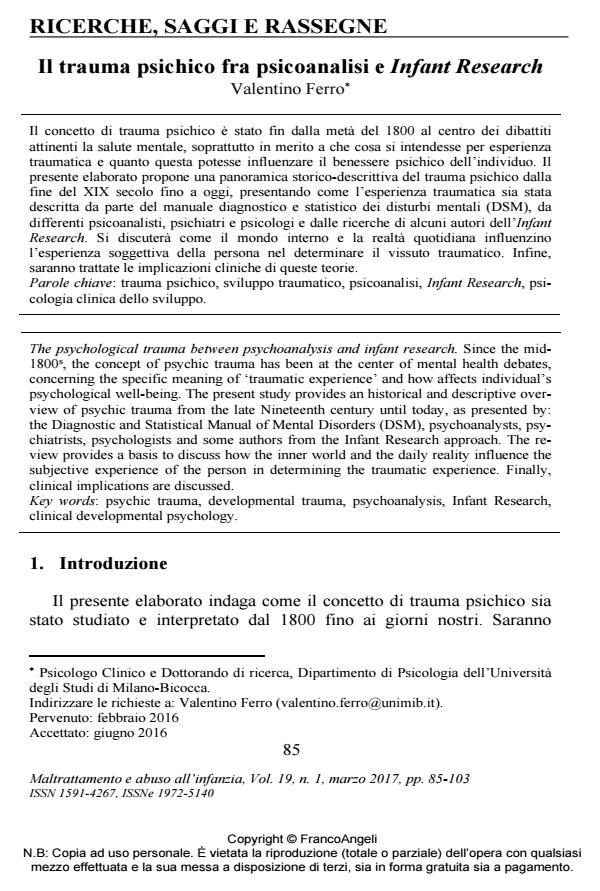The psychological trauma between psychoanalysis and infant research
Journal title MALTRATTAMENTO E ABUSO ALL’INFANZIA
Author/s Valentino Ferro
Publishing Year 2017 Issue 2017/1
Language Italian Pages 19 P. 85-103 File size 210 KB
DOI 10.3280/MAL2017-001006
DOI is like a bar code for intellectual property: to have more infomation
click here
Below, you can see the article first page
If you want to buy this article in PDF format, you can do it, following the instructions to buy download credits

FrancoAngeli is member of Publishers International Linking Association, Inc (PILA), a not-for-profit association which run the CrossRef service enabling links to and from online scholarly content.
Since the mid-1800s, the concept of psychic trauma has been at the center of mental health debates, concerning the specific meaning of ‘traumatic experience’ and how affects individual’s psychological well-being. The present study provides an historical and descriptive overview of psychic trauma from the late Nineteenth century until today, as presented by: the Diagnostic and Statistical Manual of Mental Disorders (DSM), psychoanalysts, psychiatrists, psychologists and some authors from the Infant Research approach. The review provides a basis to discuss how the inner world and the daily reality influence the subjective experience of the person in determining the traumatic experience. Finally, clinical implications are discussed.
Keywords: Psychic trauma, developmental trauma, psychoanalysis, Infant Research, clinical developmental psychology.
- Trauma complesso ed esiti di percorso nella presa in carico di minori maltrattati: uno studio pilota Antonio Maria Corato, Stefano De Carli, Chiara Fabris, Giulia Ongaro, in MALTRATTAMENTO E ABUSO ALL'INFANZIA 2/2018 pp.87
DOI: 10.3280/MAL2018-002006 - La detenzione genitoriale: l'intervento psicoeducativo per il sostegno alle famiglie Marvita Goffredo, Isabella Berlingerio, Sonia Papagna, Maria Grazia Foschino Barbaro, in MALTRATTAMENTO E ABUSO ALL'INFANZIA 2/2017 pp.101
DOI: 10.3280/MAL2017-002006
Valentino Ferro, Il trauma psichico fra psicoanalisi e Infant Research in "MALTRATTAMENTO E ABUSO ALL’INFANZIA" 1/2017, pp 85-103, DOI: 10.3280/MAL2017-001006